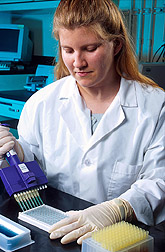This page has been archived and is being provided for reference purposes only. The page is no longer being updated, and therefore, links on the page may be invalid.
|
|
Certification Program To Give Pork a New Image. By Judy McBrideAugust 4, 2000 In a couple of years, consumers won't need to cook pork chops and roasts to the consistency of shoe leather. Starting this summer, an innovative program to certify pigs right on the farm as free of trichinosis-causing worms is going through its final shakedown--a 2-year pilot study. "The national certification program for trichinae-free pork is expected to be a model for controlling other foodborne pathogens, including some bacteria, at the source of infection," said H. Ray Gamble, a parasitologist with the Agricultural Research Service. ARS is the chief research agency of the U.S. Department of Agriculture. Gamble is collaborating on the project with the National Pork Producers Council (NPPC), the meat packing industry and two other USDA agencies, the Animal and Plant Health Inspection Service (APHIS) and the Food Safety and Inspection Service (FSIS). "ARS scientists laid the groundwork for this program from their knowledge of the Trichinella spiralis parasite," said ARS Administrator Floyd Horn. "Dr. Gamble developed an ELISA test that enables veterinarians to screen live animals for infection from a blood sample. And he involved two companies in its development and licensing. "Then, Gamble spearheaded a 2-year study of swine operations in the Northeast to validate the ELISA test and identify the management factors associated with trichinae-positive herds," Horn continued. Now, the NPPC is encouraging pork producers to volunteer for certification by having their operations audited by an APHIS-accredited veterinarian. Using a standardized checklist, the veterinarians will be looking for practices that would prevent a herd's exposure to infected rodents or wildlife or to raw garbage. Participating packing plants will keep certified pigs separate from non certified pigs and follow a protocol developed with FSIS. According to Gamble, who heads the ARS Parasite Biology and Epidemiology Laboratory in Beltsville, Md., "the fear of trichinosis is a perceived threat rather than a real one." Thanks to changes in the way most swine producers manage their operations, the number of pigs infected with T. spiralis has been on the decline for decades. For example, not a single positive animal turned up out of 220,000 pigs tested during a 6-month study in 1997. But pork still suffers from the worm's shadow, which keeps Americans overcooking the meat and has closed several overseas markets to U.S. pork producers. Gamble says the meat packers, who want to improve their product's image, have been a driving force in supporting the concept of on-farm certification. Countries in the European Union test each pig carcass for the presence of trichinae worms, a task that cost $576 million in 1998. But carcass testing is too costly and cumbersome for U.S. packers, says Gamble. So the solution has been to strictly control the preparation of processed pork products, such as sausage and ham, and to educate the public to cook fresh pork thoroughly. "The on-farm audit is an approach to food safety that holds the promise of being superior to the individual testing of pigs at slaughter," says Dave Pyburn, director of veterinary science at NPPC. Read more about the program online in the August issue of Agricultural Research magazine. Scientific contact: H. Ray Gamble, Parasite Biology and Epidemiology Laboratory, Beltsville, Md., phone (301) 504-8300, fax (301) 504-6273, rgamble@lpsi.barc.usda.gov. |

